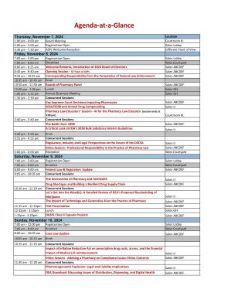Back
Drug Shortages and Building a Resilient Drug Supply Chain: An Examination of National Security Issues and Policy Solutions
Saturday, November 9, 2024
9:05 AM – 10:05 AM MT
Location: Salon ABCDEF
CE: 1

Stephen W. Schondelmeyer, PharmD, PhD, FAPhA
Professor & Director, PRIME Institute
University of Minnesota
PRIME Institute, College of Pharmacy, University of Minnesota
Minneapolis, MN, United States
Primary Presenter(s)
A robust drug supply chain is critical infrastructure for the health and well-being of all Americans. A stable drug supply relies on complex interdependencies in international relations, both commercially and politically. The United States is heavily dependent on foreign manufacturers for its pharmaceutical ingredients and finished products, particularly China and India. About 45% of finished dose form units and about 60% the active pharmaceutical ingredients (API) in drug products consumed in the U.S. come from India and/or China. This level of concentration in drug production within specific geographic areas poses significant problems in the face of natural disasters or pandemics, accidental or intentional adulteration, and challenging trade relations and geopolitical risk.
The source of our drug supply is a matter of national security. There are a number of potential policy directions that should be pursued to strengthen the resilience and security of the U.S. drug supply chain. The U.S. needs to: (1) have a strategic plan for drug supply with policies and incentives to ensure a secure and resilient supply of all essential and necessary drugs; (2) support ongoing work to identify risks and secure the supply of key starting materials and APIs for critical pharmaceuticals; (3) improve the quality of drug products through inspection and enforcement to prevent drug quality problems from lack of voluntary compliance and inadequate regulatory oversight; (4) insist that its pharmaceutical trading partners (including India) substantially participate in the International Council on Harmonization (ICH) for consistent high quality drug production; (5) encourage re-shoring, near-shoring and friend-shoring of API and finished drug production, especially for critical drugs, and increase transparency of drug production sourcing; and (6) map the upstream drug supply chain in a centralized system to effectively track, predict, and respond to drug supply issues in order to prevent and eliminate shortages.
The source of our drug supply is a matter of national security. There are a number of potential policy directions that should be pursued to strengthen the resilience and security of the U.S. drug supply chain. The U.S. needs to: (1) have a strategic plan for drug supply with policies and incentives to ensure a secure and resilient supply of all essential and necessary drugs; (2) support ongoing work to identify risks and secure the supply of key starting materials and APIs for critical pharmaceuticals; (3) improve the quality of drug products through inspection and enforcement to prevent drug quality problems from lack of voluntary compliance and inadequate regulatory oversight; (4) insist that its pharmaceutical trading partners (including India) substantially participate in the International Council on Harmonization (ICH) for consistent high quality drug production; (5) encourage re-shoring, near-shoring and friend-shoring of API and finished drug production, especially for critical drugs, and increase transparency of drug production sourcing; and (6) map the upstream drug supply chain in a centralized system to effectively track, predict, and respond to drug supply issues in order to prevent and eliminate shortages.
Learning Objectives:
- Describe the extent of U.S. reliance on foreign countries for production of prescription drug products, and especially critical drugs.
- Identify policy actions that would be expected to improve the quality of drug production for the U.S. market.
- List policy options that the U.S. should consider to strengthen the resilience and security of the U.S. drug supply chain.
- Explain how a comprehensive drug supply map could enable the U.S. to track, predict, and respond to drug supply issues in order to prevent and eliminate shortages.

